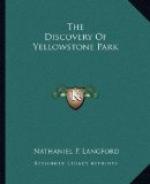Lieutenant Doane and I were somewhat fatigued with our climb of four hours’ duration, and we refreshed ourselves with such creature comforts as we found on the summit; but, although we attained the “crest,” we did not discern any “free and generous spirit,” save that which we saw “through a glass darkly.”
At the point where we left our horses there was, on the east slope of the mountain, a body of snow, the surface of which was nearly horizontal, and the outer edge of which was thirty feet in perpendicular height. This body of snow is perpetual. At this point the elevation, as indicated by our aneroid barometer, was 9,476 feet, while at the summit it was 10,327 feet, a difference of 581 feet, which was the broken granite summit.
The descent occupied an hour and a quarter, when we struck the trail of the pack train near the base of the mountain, which we followed until we found three poles placed in the form of a tripod, the longer pole pointing to the right to indicate that at this point the party had changed its course.
[Illustration: Marker made of sticks.]
Obeying this Indian sign, we descended the bank bordering the valley and traversed the bottom lands to the river, which we forded at a point where it was about ninety feet wide and three feet deep, with a current of about six miles an hour. This was about six or seven miles from the mouth of the river. We followed the trail of the advance party through a beautiful pine forest, free from underbrush, for the distance of two miles, passing two beautiful lakes. By this time night had overtaken us, and it was with difficulty that we could follow the trail, the tracks of the horses’ shoes, which were our sole guide, being hardly discernible. But we pressed on, following the dark, serpentine line of freshly disturbed earth till it turned up the side of the mountain, where we followed it for upwards of a mile. Fearing lest we were not upon the right trail, we dismounted, and, placing our faces close to the ground, examined it carefully, but could not discover the impression of a single horseshoe. Gathering a few dry branches of pine, we kindled a fire upon the trail, when we discovered that we had been following, from the base of the mountain, the trail of a band of elk that had crossed the line of travel of the pack train at a point near the base of the mountain, and in the dim twilight we had not discovered the mistake.
[Illustration: MAP OF YELLOWSTONE LAKE, AS KNOWN BETWEEN 1860 AND 1870. FROM THE MAP OF RAYNOLDS’ EXPEDITION OF 1860.]
The prospect for a night on the mountain, without blankets or supper, seemed now very good; but we retraced our steps as rapidly as possible, and on reaching the base of the mountain, struck out for the lake, resolving to follow the beach, trusting that our party had made their camp on the shore of the lake, in which case we should find them; but if camped at any considerable distance from the shore, we should not find them.




